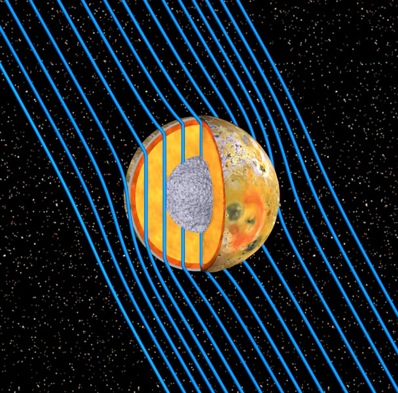
Magma ocean found in Jupiter's volcanic moon
DR EMILY BALDWIN
ASTRONOMY NOW
Posted: 13 May 2011


Nearly a decade after NASA's Galileo mission concluded, scientists analysing its data have found the first direct evidence of its kind for Jupiter's volcanic moon Io possessing a global magma ocean underneath its crust.
Active volcanoes were detected on Jupiter's innermost moon by the Voyager I spacecraft in 1979, and Io soon gained the title of "most volcanically active body in the Solar System" – it produces 100 times more lava than the Earth each year, despite being around one-third smaller. Energy to produce such prolific volcanism comes from intense tidal interactions with Jupiter, which stretches and squeezes tiny Io as it orbits the giant planet.
Newly analysed data of Io's interaction with Jupiter's magnetic field reveals that Io possesses a subsurface ocean of molten or partially molten magma 30-50 kilometres beneath its crust, making up at least 10 percent of the moon’s mantle by volume and likely exceeding temperatures of 1,200 Celsius.

The internal structure of Jupiter's moon Io as revealed by data from NASA's Galileo spacecraft. The low-density crust about 30 to 50 kilometres thick is shown in grey, the newly discovered subsurface magma ocean is shown in red-brown beneath the crust, and the mantle is shown in gold. Variations in the magnetic field line signatures from Jupiter (blue) revealed Io's internal structure. Image: NASA/JPL/University of Michigan/UCLA.
“During the final phase of the Galileo mission, models of the interaction between Io and Jupiter’s immense magnetic field, which bathes the moon in charged particles, were not yet sophisticated enough for us to understand what was going on in Io’s interior,” says Xianzhe Jia of the University of Michigan, one of the scientists working on the Galileo data.
As Jupiter rotates, its magnetic field around Io strengthens and weakens, but Io's magma ocean was seen to deflect the varying magnetic field, shielding the inside of the moon from magnetic disturbances such that the magnetic field inside of Io maintained a vertical orientation, even as the magnetic field outside of Io varied. It was these magnetic field signatures that enabled scientists to understand the moon's internal structure.
Lead author Krishan Khurana and former co-investigator on Galileo’s magnetometer team at UCLA is pleased to finally understand where Io’s magma is coming from and have an explanation for some of the mysterious signatures they saw in some of the Galileo’s magnetic field data. “It turns out Io was continually giving off a ‘sounding signal’ in Jupiter’s rotating magnetic field that matched what would be expected from molten or partially molten rocks deep beneath the surface.”
Specifically, the signatures detected by Galileo match a rock type on Earth called Iherzolite, an igneous rock originating from Earth's mantle rich in silicates of magnesium and iron.
“It has been suggested that both the Earth and its Moon may have had similar magma oceans billions of years ago at the time of their formation, but they have long since cooled,” comments Torrence Johnson, a former Galileo project scientist based at NASA’s Jet Propulsion Laboratory but not directly involved in the study. “Io’s volcanism informs us how volcanoes work and provides a window in time to styles of volcanic activity that may have occurred on the Earth and Moon during their earliest history.”
The Galileo spacecraft was deliberately smashed into Jupiter at the end of its eight year mission in 2003.
|



